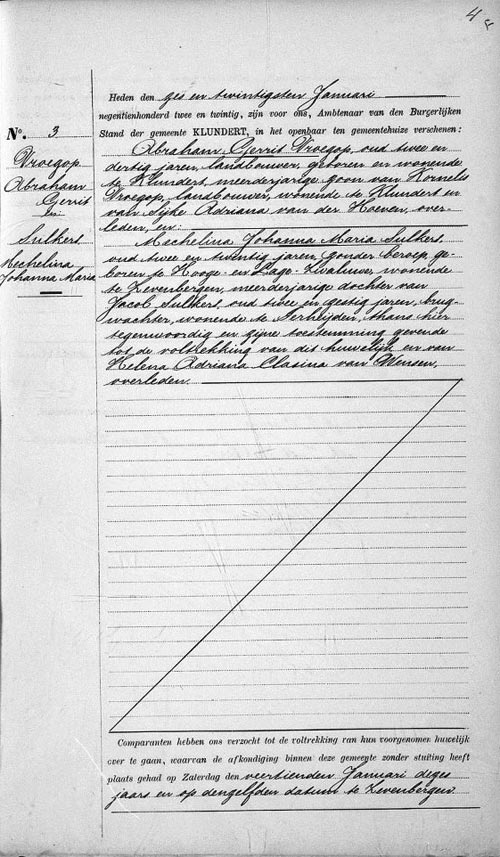Marriage records are a part of the civil registration, introduced in 1811 or slightly earlier in Limburg and Zeeuws-Vlaanderen. Marriage records contain the following information:
- Name, age, profession and place of birth and residence of the bride and groom
- Names of their parents, and if they are still alive their professions and place of residence
- If any: names of previous spouses (either divorced or deceased)
- Name, age, profession and place of residence for 4 witnesses
Marriage records are written on the day of the marriage. Since the introduction of the civil registration, church marriages were not legally binding. Religious people typically married twice: once for the church and once for the law. This doesn’t even have to be on the same day, some people marry for the church months or years after they get married for the law, but usually the civil and church marriage dates are pretty close. The only legal marriage is the one before the civil registration.
Marriage appendices
Before a couple can get married, they had to turn over many different documents:
- Birth certificates for bride and groom
- Death certificates for any deceased parents. In the early days of the civil registration death certificates of the grandparents were required as well if both parents were dead.
- Death certificates for deceased previous spouses.
- If parents were absent: Document of their consent.
- Certificate to proove the groom fulfilled his military duties. This document often includes a physical description.
- In case of poor people: a declaration of poverty, which meant they didn’t have to pay the legal fees.
These documents were stored as well. They are called ‘marriage appendices’ (huwelijksbijlagen).
Example

Where to find
Marriage records and the appendices are public after 75 years. The marriage records can be found at both the provincial archives and local archives. The appendices are not duplicated and can only be found at the provincial archives.
All of the provincial archives are working on making their public marriage records available online in the website WieWasWie.
Dutch Genealogy source score
 Amount of information about births, marriages, deaths
Amount of information about births, marriages, deaths
 Amount of background information about your ancestors
Amount of background information about your ancestors
 Online availability of scans
Online availability of scans
 Online availability of indexes or transcriptions
Online availability of indexes or transcriptions
 Easy to understand if you don’t know Dutch
Easy to understand if you don’t know Dutch


Thanks, this explains a lot of birth events with my ancestors in Zealand. Especially in one case when the child was born one month before the civil marriage. Both parents are listed on the birth notice so I know that the child was not born out of wedlock. Thanks the explanation of the church and civil marriages being separate helps solve a mystery.
Hi Larry,
I’m not sure I follow. If the child was born a month before the civil marriage, then the child was born out of wedlock. The fact that both parents are mentioned on the birth record doesn’t say the child was legitimate, just that the father acknowledged the child. The specific wording of the record is important to see what the child’s legal status was. Also, I’ve not seen cases where the church marriage was before the civil marriage, only the other way around.
I am trying to find out which Amsterdam Catholic Church my parents were married in. My parents wedding was on 21 January 1940. Their names were Thomas W J Grondman and Maria Agnes Wojak. Are you able to find out which church it was?
Hello,
What a wonderful site. I am trying to find the dates of my dutch grandparents marriage. So their marriage certificate. How would I go a out this? Also, is there any way I can find out the dates their last passports were issued? They are both deceased.
Many thanks in advance.
Here are some free websites you can search: https://www.dutchgenealogy.nl/free-alternatives-to-wiewaswie/
I don’t know any sources that record when passports were issued.
Wonderful!
Thank you for your help! : )